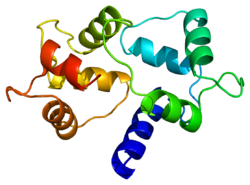1a29: CALMODULIN COMPLEXED WITH TRIFLUOPERAZINE (1:2 COMPLEX)
1ahr: CALMODULIN MUTANT WITH A TWO RESIDUE DELETION IN THE CENTRAL HELIX
1ak8: NMR SOLUTION STRUCTURE OF CERIUM-LOADED CALMODULIN AMINO-TERMINAL DOMAIN (CE2-TR1C), 23 STRUCTURES
1cdl: TARGET ENZYME RECOGNITION BY CALMODULIN: 2.4 ANGSTROMS STRUCTURE OF A CALMODULIN-PEPTIDE COMPLEX
1cdm: MODULATION OF CALMODULIN PLASTICITY IN MOLECULAR RECOGNITION ON THE BASIS OF X-RAY STRUCTURES
1cfc: CALCIUM-FREE CALMODULIN
1cfd: CALCIUM-FREE CALMODULIN
1cff: NMR SOLUTION STRUCTURE OF A COMPLEX OF CALMODULIN WITH A BINDING PEPTIDE OF THE CA2+-PUMP
1ckk: CALMODULIN/RAT CA2+/CALMODULIN DEPENDENT PROTEIN KINASE FRAGMENT
1cll: CALMODULIN STRUCTURE REFINED AT 1.7 ANGSTROMS RESOLUTION
1cm1: MOTIONS OF CALMODULIN-SINGLE-CONFORMER REFINEMENT
1cm4: MOTIONS OF CALMODULIN-FOUR-CONFORMER REFINEMENT
1cmf: NMR SOLUTION STRUCTURE OF APO CALMODULIN CARBOXY-TERMINAL DOMAIN
1cmg: NMR SOLUTION STRUCTURE OF CALCIUM-LOADED CALMODULIN CARBOXY-TERMINAL DOMAIN
1ctr: DRUG BINDING BY CALMODULIN: CRYSTAL STRUCTURE OF A CALMODULIN-TRIFLUOPERAZINE COMPLEX
1deg: THE LINKER OF DES-GLU84 CALMODULIN IS BENT AS SEEN IN THE CRYSTAL STRUCTURE
1dmo: CALMODULIN, NMR, 30 STRUCTURES
1f70: REFINED SOLUTION STRUCTURE OF CALMODULIN N-TERMINAL DOMAIN
1f71: REFINED SOLUTION STRUCTURE OF CALMODULIN C-TERMINAL DOMAIN
1fw4: CRYSTAL STRUCTURE OF E. COLI FRAGMENT TR2C FROM CALMODULIN TO 1.7 A RESOLUTION
1g4y: 1.60 A CRYSTAL STRUCTURE OF THE GATING DOMAIN FROM SMALL CONDUCTANCE POTASSIUM CHANNEL COMPLEXED WITH CALCIUM-CALMODULIN
1iq5: Calmodulin/nematode CA2+/Calmodulin dependent kinase kinase fragment
1iwq: Crystal Structure of MARCKS calmodulin binding domain peptide complexed with Ca2+/Calmodulin
1j7o: Solution structure of Calcium-calmodulin N-terminal domain
1j7p: Solution structure of Calcium calmodulin C-terminal domain
1k90: Crystal structure of the adenylyl cyclase domain of anthrax edema factor (EF) in complex with calmodulin and 3' deoxy-ATP
1k93: Crystal structure of the adenylyl cyclase domain of anthrax edema factor (EF) in complex with calmodulin
1l7z: Crystal structure of Ca2+/Calmodulin complexed with myristoylated CAP-23/NAP-22 peptide
1lin: CALMODULIN COMPLEXED WITH TRIFLUOPERAZINE (1:4 COMPLEX)
1lvc: Crystal structure of the adenylyl cyclase domain of anthrax edema factor (EF) in complex with calmodulin and 2' deoxy, 3' anthraniloyl ATP
1mux: SOLUTION NMR STRUCTURE OF CALMODULIN/W-7 COMPLEX: THE BASIS OF DIVERSITY IN MOLECULAR RECOGNITION, 30 STRUCTURES
1mxe: Structure of the Complex of Calmodulin with the Target Sequence of CaMKI
1niw: Crystal structure of endothelial nitric oxide synthase peptide bound to calmodulin
1nwd: Solution Structure of Ca2+/Calmodulin bound to the C-terminal Domain of Petunia Glutamate Decarboxylase
1ooj: Structural genomics of Caenorhabditis elegans : Calmodulin
1pk0: Crystal Structure of the EF3-CaM complexed with PMEApp
1prw: Crystal structure of bovine brain Ca++ calmodulin in a compact form
1qiv: CALMODULIN COMPLEXED WITH N-(3,3,-DIPHENYLPROPYL)-N'-[1-R-(3,4-BIS-BUTOXYPHENYL)-ETHYL]-PROPYLENEDIAMINE (DPD), 1:2 COMPLEX
1qiw: CALMODULIN COMPLEXED WITH N-(3,3,-DIPHENYLPROPYL)-N'-[1-R-(3,4-BIS-BUTOXYPHENYL)-ETHYL]-PROPYLENEDIAMINE (DPD)
1qs7: The 1.8 angstrom structure of calmodulin rs20 peptide complex
1qtx: THE 1.65 ANGSTROM STRUCTURE OF CALMODULIN RS20 PEPTIDE COMPLEX
1qx5: Crystal structure of apoCalmodulin
1qx7: Crystal structure of apoCaM bound to the gating domain of small conductance Ca2+-activated potassium channel
1s26: Structure of Anthrax Edema Factor-Calmodulin-alpha,beta-methyleneadenosine 5'-triphosphate Complex Reveals an Alternative Mode of ATP Binding to the Catalytic Site
1sk6: Crystal structure of the adenylyl cyclase domain of anthrax edema factor (EF) in complex with calmodulin, 3',5' cyclic AMP (cAMP), and pyrophosphate
1sw8: Solution structure of the N-terminal domain of Human N60D calmodulin refined with paramagnetism based strategy
1sy9: Structure of calmodulin complexed with a fragment of the olfactory CNG channel
1up5: CHICKEN CALMODULIN
1vrk: THE 1.9 ANGSTROM STRUCTURE OF E84K-CALMODULIN RS20 PEPTIDE COMPLEX
1wrz: Calmodulin complexed with a peptide from a human death-associated protein kinase
1x02: Solution structure of stereo array isotope labeled (SAIL) calmodulin
1xa5: Structure of Calmodulin in complex with KAR-2, a bis-indol alkaloid
1xfu: Crystal structure of anthrax edema factor (EF) truncation mutant, EF-delta 64 in complex with calmodulin
1xfv: Crystal structure of anthrax edema factor (EF) in complex with calmodulin and 3' deoxy-ATP
1xfw: Crystal structure of anthrax edema factor (EF) in complex with calmodulin and 3'5' cyclic AMP (cAMP)
1xfx: Crystal structure of anthrax edema factor (EF) in complex with calmodulin in the presence of 10 millimolar exogenously added calcium chloride
1xfy: Crystal structure of anthrax edema factor (EF) in complex with calmodulin
1xfz: Crystal structure of anthrax edema factor (EF) in complex with calmodulin in the presence of 1 millimolar exogenously added calcium chloride
1y0v: Crystal structure of anthrax edema factor (EF) in complex with calmodulin and pyrophosphate
1y6w: Trapped intermediate of calmodulin
1yr5: 1.7-A structure of calmodulin bound to a peptide from DAP kinase
1yrt: Crystal Structure analysis of the adenylyl cyclaes catalytic domain of adenylyl cyclase toxin of Bordetella pertussis in presence of c-terminal calmodulin
1yru: Crystal Structure analysis of the adenylyl cyclaes catalytic domain of adenylyl cyclase toxin of Bordetella pertussis in presence of c-terminal calmodulin and 1mM calcium chloride
1zot: crystal structure analysis of the CyaA/C-Cam with PMEAPP
1zuz: Calmodulin in complex with a mutant peptide from human DRP-1 kinase
2bbm: SOLUTION STRUCTURE OF A CALMODULIN-TARGET PEPTIDE COMPLEX BY MULTIDIMENSIONAL NMR
2bbn: SOLUTION STRUCTURE OF A CALMODULIN-TARGET PEPTIDE COMPLEX BY MULTIDIMENSIONAL NMR
2bcx: Crystal structure of calmodulin in complex with a ryanodine receptor peptide
2be6: 2.0 A crystal structure of the CaV1.2 IQ domain-Ca/CaM complex
2bkh: MYOSIN VI NUCLEOTIDE-FREE (MDINSERT2) CRYSTAL STRUCTURE
2bki: MYOSIN VI NUCLEOTIDE-FREE (MDINSERT2-IQ) CRYSTAL STRUCTURE
2col: Crystal structure analysis of CyaA/C-Cam with Pyrophosphate
2dfs: 3-D structure of Myosin-V inhibited state
2f2o: Structure of calmodulin bound to a calcineurin peptide: a new way of making an old binding mode
2f2p: Structure of calmodulin bound to a calcineurin peptide: a new way of making an old binding mode
2f3y: Calmodulin/IQ domain complex
2f3z: Calmodulin/IQ-AA domain complex
2fot: Crystal structure of the complex between calmodulin and alphaII-spectrin
2hf5: The structure and function of a novel two-site calcium-binding fragment of calmodulin
2ix7: STRUCTURE OF APO-CALMODULIN BOUND TO UNCONVENTIONAL MYOSIN V
3cln: STRUCTURE OF CALMODULIN REFINED AT 2.2 ANGSTROMS RESOLUTION
4cln: STRUCTURE OF A RECOMBINANT CALMODULIN FROM DROSOPHILA MELANOGASTER REFINED AT 2.2-ANGSTROMS RESOLUTION




















































































